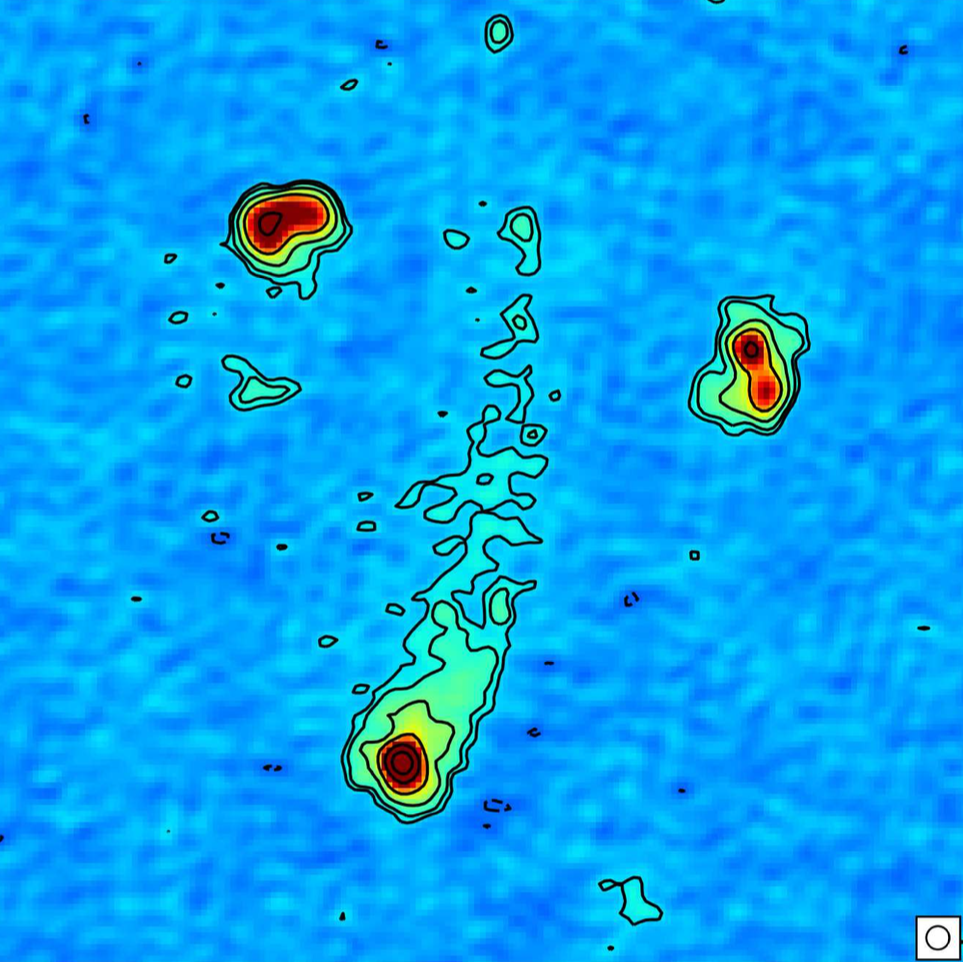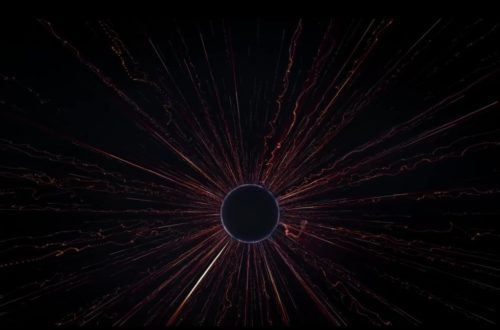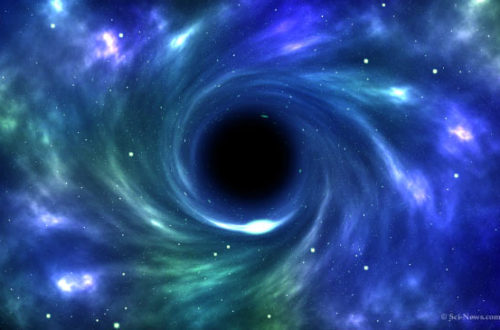Radio galaxies are a class of active galactic nuclei that shine very brightly at radio frequencies but also radiate across the entire electromagnetic spectrum too. Powered by accretion of matter onto a central fast-spinning supermassive black hole, radio galaxies can display extended radio structures- jets. Jets emit radiation strongly at radio frequencies and can propagate hundreds of kiloparsecs (1 kiloparsec = 3.086 x 1016 km) or more beyond the central black hole that powers them. Jets travel with relativistic velocities, carrying large amounts of energy with them to regions well outside the confines of their host galaxy. Radio galaxies which display these jets can be classified based on their morphology (appearance) when observed at radio frequencies.
FRII radio galaxies
FRII (Fanaroff-Riley type II, see Fig. 1) radio galaxies are edge-brightened: FR II radio galaxies display jets that are brightest at their leading edges, in the regions furthest away from their host galaxy when observed at radio frequencies. Jets in FRII radio galaxies are powerful and are believed to maintain velocities that are highly relativistic and supersonic with respect to their surroundings. This results in the highly focused jets shown in Fig. 1. The brightening at their extremities is due to the presence of strong shocks which mark the abrupt termination of the jet.
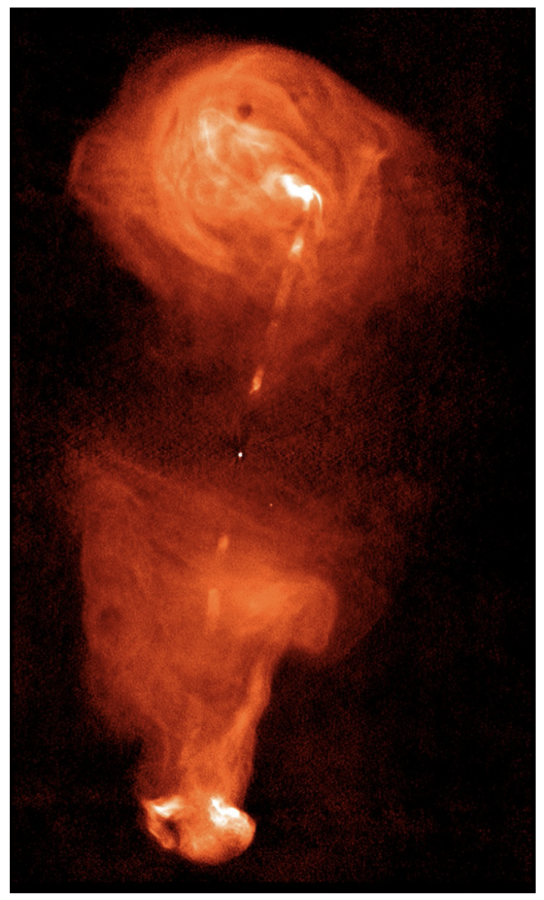
FRI radio galaxies
FRI (Fanaroff-Riley type I, see Fig. 2) radio galaxies are edge-darkened: FRI galaxies have jets that are brightest at shorter distances from their host galaxy and are dim at their leading ends. Jets with FRI morphology are comparatively weaker than FRII jets and are believed to decelerate to mildly relativistic, transonic or subsonic velocities with respect to their surrounding environment. This results in turbulent and disrupted jets that often display large scale bends and wiggles as shown in Fig 2. FRI jets do not terminate abruptly, but instead smoothly transition into meandering plume structures.
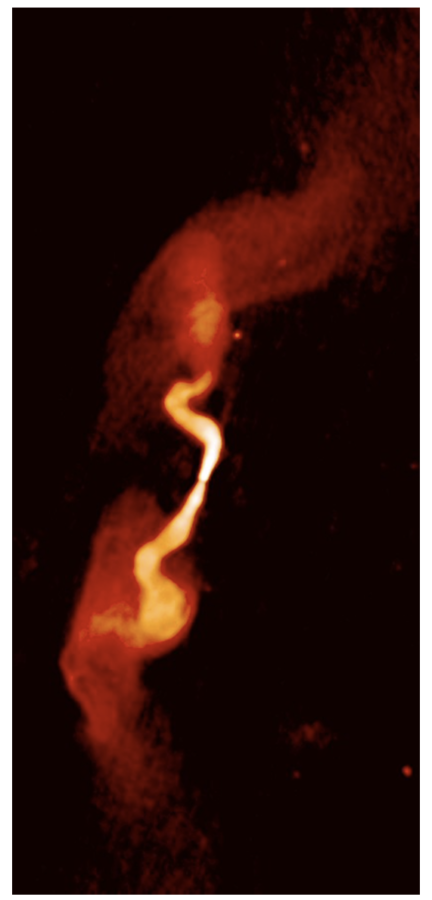
But there now appears to be another group of radio galaxies, which displays different radio morphology to that observed in FRI and FRII radio galaxies.
FR0 radio galaxies
A relatively new class of radio galaxy has emerged from recent high sensitivity radio and optical surveys such as the (Sloan Digital Sky Survey (SDSS), the Faint Images of the Radio Sky at Twenty centimetres survey (FIRST) and the National Radio Astronomy Observatory Very Large Array (VLA) Sky Survey (NVSS) and the LOFAR Two-metre Sky Survey (LoTSS, Shimwell et al. 2017).
FR0s (Fanaroff-Riley type 0, see Fig. 3) lack the substantial, large-scale extended radio structures typical of FRI and FRII radio sources (see Baldi et al. 2015 and references therein). FR0s instead often display short, weak jets that extend a few to 10s of kiloparsecs (Nagar et al. 2005, Baldi et al. 2019) from the central black hole. The observed jets in FR0s are ~10-1000 times weaker than those in typical FRI radio galaxies. However, despite being weak, FR0 jets likely still inject a significant amount of energy into the interstellar medium of their host galaxies.
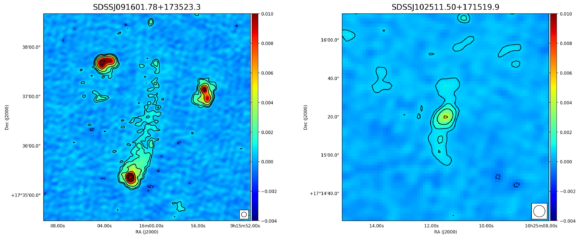
Except for their lack of significant extended radio jets, FR0s are a family of active galaxies with very similar properties to FRI radio galaxies, but with one other notable difference- the ratio of their core emission to their total emission is about 30 times higher than that of FRI sources (Garofalo & Singh 2019). FR0s are an abundant population of radio galaxies, dominating both FRI and FRII radio galaxies- FR0s are five times more numerous than FRIs in the local Universe (redshift z < 0.05). FR0s are typically located in small groups of galaxies, with each group containing less than ~15 galaxies (Capetti et al. 2020).
Despite the fact that FR0s outnumber FRIs, the weak and compact radio emission of the former makes them difficult to study and we currently only obtain very little information from their observations. Consequently there are still many open questions surrounding FR0 radio galaxies: What is the origin of this class of radio galaxy? What are the reasons behind their compact, confined radio jet structure? How are they related to FRI and FRII radio galaxies? Are FR0s young FRI radio galaxies?
Perhaps FR0s are powered by a slowly spinning black hole (spin parameter a = 0.1, Baldi et al. 2015, 2017), limiting the amount of extracted energy available to launch and power the jet, thus resulting in the compact, weak jets observed in FR0s. Maybe FR0s are early-stage FRIs and will eventually evolve into the latter over a period of millions of years (e.g. Garofalo & Singh 2019). Maybe the jets in FR0s are highly intermittent, switching on and off frequently during the course of their evolution (Baldi et al. 2015), resulting in the absence of prominent extended radio jets in these radio galaxies. High spatial resolution observations of FR0s conducted with the next generation of radio telescopes, such as the Square Kilometre Array (SKA), will reveal a wealth of new information about these radio sources.

